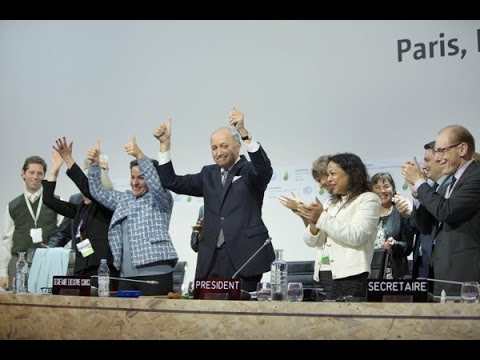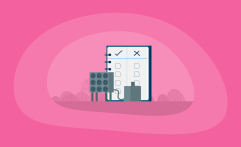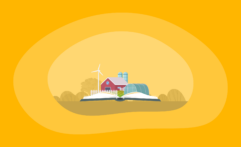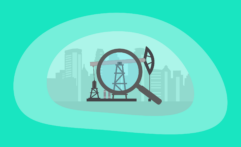The History of Hydropower: The Big Picture
Impactful Ninja is reader-supported. When you buy through links on our site, we may earn an affiliate commission.
Learn more
Learn more
.
Hey fellow impactful ninja ? You may have noticed that Impactful Ninja is all about providing helpful information to make a positive impact on the world and society. And that we love to link back to where we found all the information for each of our posts. Most of these links are informational-based for you to check out their primary sources with one click. But some of these links are so-called "affiliate links" to products that we recommend. First and foremost, because we believe that they add value to you. For example, when we wrote a post about the environmental impact of long showers, we came across an EPA recommendation to use WaterSense showerheads. So we linked to where you can find them. Or, for many of our posts, we also link to our favorite books on that topic so that you can get a much more holistic overview than one single blog post could provide. And when there is an affiliate program for these products, we sign up for it. For example, as Amazon Associates, we earn from qualifying purchases. First, and most importantly, we still only recommend products that we believe add value for you. When you buy something through one of our affiliate links, we may earn a small commission - but at no additional costs to you. And when you buy something through a link that is not an affiliate link, we won’t receive any commission but we’ll still be happy to have helped you. When we find products that we believe add value to you and the seller has an affiliate program, we sign up for it. When you buy something through one of our affiliate links, we may earn a small commission (at no extra costs to you). And at this point in time, all money is reinvested in sharing the most helpful content with you. This includes all operating costs for running this site and the content creation itself. You may have noticed by the way Impactful Ninja is operated that money is not the driving factor behind it. It is a passion project of mine and I love to share helpful information with you to make a positive impact on the world and society. However, it's a project in that I invest a lot of time and also quite some money. Eventually, my dream is to one day turn this passion project into my full-time job and provide even more helpful information. But that's still a long time to go. Stay impactful,Affiliate Disclosure
Why do we add these product links?
What do these affiliate links mean for you?
What do these affiliate links mean for us?
What does this mean for me personally?
![]()
Harnessing the energy of moving water is a low-emissions process that can help ensure a sustainable planet for future generations. Over the years, hydropower has evolved into our leading renewable energy technology. So, we had to ask: What is the history of hydropower?
Hydropower began in 300 BC with the invention of the water wheel. Then, the water turbine was invented in 1827 and the first hydroelectric facility was constructed in 1882. Technology advancements in the 20th and 21st centuries led to hydropower being our leading renewable energy technology today.
One way to combat the current global climate crisis threatening Earth’s environmental, economic, and social health is to transition away from traditional fossil fuels and toward renewable energy sources, such as hydropower. Keep reading to learn how hydropower came to be, who and what pioneered its development, how effective it has been thus far, and what the future of hydropower could entail.
Here’s the History of Hydropower in a Nutshell
From Greek water wheels to Egyptian water screws to modern water turbines, we have been using water as a source of energy for thousands of years. The principle remains the same, but years of research and development have provided various technologies to more efficiently capture the energy of moving water.
Hydropower energy is defined as the conversion of moving water into electrical energy through the use of various types of hydroelectric facilities.
“Hydropower: hydroelectric power (= the production of electricity by the force of fast-moving water)”
Cambridge Dictionary
The most common form of hydropower is an impoundment facility, sometimes called a storage facility. Impoundment facilities utilize dams to store water in a reservoir. Water released from the reservoirs flows through turbines, which spin and activate generators to produce electricity.
Hydropower has gone through three distinct development phases in its development:
- Early market formation and innovation: Water was used to perform simple yet labor-intensive tasks long before it was used to produce electricity. The early history of hydropower energy dates back to 300 BC with the invention of the water wheel to grind grain.
- Consolidation and strengthening: The Industrial Revolution kickstarted the modern hydroelectric movement, with the invention of the water turbine and the establishment of the first hydroelectric facilities helping to shape the hydropower market.
- Mainstreaming: Hydropower energy began to establish itself as a part of the mainstream electricity industry in the 20th century with the refinement of the water turbine and the establishment of the first hydroelectric facilities. The establishment of the International Energy Agency (IEA), the International Hydropower Association (IHA), and the IEA Hydropower Technology Collaboration Programme helped to regulate the hydropower energy market.
| Hydropower Milestones | Historical Event |
| Initial start | The early history of hydropower dates back to 300 BC. The most common use of hydropower in ancient times included the use of water wheels to grind grain. |
| Milestones in hydropower development | 1771: Richard Arkwright invented the water frame, a water-powered machine to spur the Industrial Revolution. 1827: Benoit Fourneyron invented the first water turbine. 1849: James Francis invented the Francis turbine, which is still the most commonly used one today. 1870s: Lester Allan Pelton invented the impulse water turbine. 1878: The world’s first hydroelectric project was established in England. 1882: The world’s first hydroelectric power plant was constructed. 1895: The largest and first alternating current electricity-generating hydropower plant was constructed. 1940-1970: Hydropower capacity greatly increased after World War II. 2000-2017: Installed hydropower capacity increased by 65%. 2023: Hydropower accounts for over 60% of our renewable energy generation. |
| Current status | Currently, hydropower accounts for roughly 15% of total global electricity generation, generating over 4,400 terawatt-hours (TWh) of electricity from 1,397 gigawatts (GW) of installed capacity. |
| Future outlook | The future of hydropower will be heavily influenced by climate change and other emerging technologies. Experts predict hydropower will remain our largest source of renewable energy into the 2030s, although it will eventually be overtaken by wind and solar energy. |
| Key policy developments | 1974: International Energy Agency (IEA) 1975: IEA Hydropower Technology Collaboration Program 1995: The International Hydropower Association (IHA) 2009: The International Renewable Energy Agency (IRENA) 2015: Paris Climate Agreement |
Understanding hydropower’s history can provide insight into how it has evolved into the renewable energy source it is today.
When and How Did Hydropower Get Started
Water was used to perform simple yet labor-intensive tasks long before it was used to produce electricity. The most common use of hydropower in ancient times included the use of water wheels to grind grain.
300 BC-500 AD: The ancient Roman Empire and eastern Mediterranean region used water wheels to grind grain into flour. The Chinese used trip hammers powered by water wheels to grind grain, break ore, and in paper-making.
500-1500 AD: Hydropower migrated to Europe and Asia, where the ancient water wheel designs were refined and improved. Tide mills, water mills driven by the rising and falling of tides, began popping up along coastlines.
1500-1850: Water wheels are continuously being improved, it is discovered that mills can be powered by falling water at heights of 10-15 feet.
How Has Hydropower Developed Over Time
Hydropower remains one of the world’s oldest and largest sources of renewable energy, accounting for over one-third of our renewable energy capacity and over half of our renewable electricity generation. It can play an important role in the global energy transformation and help transition away from fossil fuels.
What Are Milestones in Hydropower Development
The Industrial Revolution kickstarted the modern hydroelectric movement, which today has grown into a $200+ billion industry.
1771: English textile manufacturer Richard Arkwright invented the water frame, a water-powered machine that spun cotton into yarn. This machine made it possible to mass-produce yarn (instead of spinning cotton by hand) and helped spur the Industrial Revolution.
1827: French engineer Benoit Fourneyron invented the water turbine. His model consisted of a six-horsepower unit where water was directed onto blades or vanes set at angles in a rotor.
1849: British–American engineer James Francis invented the Francis turbine, which was the first hydraulic turbine to have a radial inflow, whereby water enters the turbine perpendicular to the rotational axis. The Francis turbine is still the most commonly used turbine in hydropower plants today.
1870s: American inventor Lester Allan Pelton invented the impulse water turbine, which used the kinetic energy of water striking cupped blades to cause rotation. Pelton is widely considered to be the father of modern hydroelectric power.
1878: The world’s first hydroelectric project was in England, where the electricity produced was used to power a single lamp.
1882: The world’s first hydroelectric power plant was constructed on the Fox River in Appleton, Wisconsin.
1895: The Edward Dean Adams Power Plant, the world’s largest and first alternating current electricity-generating hydropower plant, was constructed at Niagara Falls. The plant was able to transport electricity over 200 miles.
1913: Austrian professor Viktor Kaplan invented the Kaplan turbine, which consisted of a propeller with adjustable blades. This turbine combines automatically adjusted propeller blades and wicket gates to achieve efficiency over a wide range of flow and water levels.
1940-1970: Hydropower installed capacity greatly increased as a result of post-World War II economic and population growth.
1984: The Itaipu Dam, in South America, opened in 1984 with a capacity of 12,600 megawatts (MW), the largest at the time.
2003: The Three Gorges Dam was constructed in China. It remains the largest hydroelectric facility in the world today with a capacity of 22,500 MW.
2000-2017: nearly 500 GW in hydropower installed capacity was added worldwide, representing an increase of 65%, the largest to date.
2023: Hydropower accounts for over 60% of our renewable energy generation.
How Has the Hydropower Market Developed Recently
The beginning of the 20th century saw a drastic rise in hydropower popularity as it was deemed a reliable, cheap, and consistent form of energy. The 21st century has seen slow but steady installed capacity growth.
2019: Global installed hydropower capacity was 1,308 GW, and the sector generated 4,306 TWh of electricity.
2020: Global installed hydropower capacity was 1,330 GW, and the sector generated 4,370 TWh of electricity.
2021: Global installed hydropower capacity was 1,360 GW, and the sector generated 4,250 TWh of electricity.
2022: Global installed hydropower capacity was 1,397 GW, and the sector generated 4,408 TWh of electricity.
Experts predict hydropower generation will decline slightly (1.3%) in 2023 as a result of global droughts, but more specifically due to droughts in China, the world’s largest hydropower producer.
What Is the Present Status of Hydropower
Hydropower is currently our largest renewable energy technology. It accounted for roughly 15% of total global electricity generation in 2022, generating over 4,400 TWh of electricity from 1,397 GW of installed capacity.
The 5 countries that together account for roughly 750 gigawatts (GW), or over half of our global hydropower capacity, are:
- China – 415 GW
- Brazil- 110 GW
- US – 102 GW
- Canada – 83 GW
- Russia- 56 GW

In terms of funding, global hydropower investment decreased by 10% in 2022 down to $65 billion. And further investment decreases are predicted in future years, meaning more effort is needed to keep hydropower on track in the IEA’s Net Zero by 2050 Scenario.
Persistent droughts, a lack of funding, and increasing interest in both solar and wind energy have led to a slowdown in hydropower capacity additions. The IEA has thus labeled hydropower as ‘more efforts needed’ in their Net Zero by 2050 Scenario. Without major policy changes, hydropower capacity and electricity generation are predicted to continue to slow.

Scenario, 2015-2030
Hydropower prevents the emission of 3 gigatons (GT) of CO2 per year, approximately 9% of our global annual emissions. However, climate change threatens to alter hydrology, which can impact water availability and hydropower energy generation. The future of hydropower will be heavily influenced by the severity of climate change, and what we do to mitigate it.
How Will the Future of Hydropower Look Like
Since 2000, hydropower installed capacity has grown by 70%. Yet, its share of total energy generation has remained the same due to equal or greater growth in the wind, solar PV, coal, and natural gas sectors.
How Hydropower Will Likely Develop in the Future
Experts predict hydropower will remain our largest source of renewable energy into the 2030s. Although it will eventually be taken over by wind energy and solar energy, hydropower is expected to continue to play a key role in the renewable energy movement. This is because hydropower:
- Has a low carbon footprint: On a life-cycle basis, hydropower generally emits 24 grams (g) of CO2 equivalent per kilowatt-hour (kWh) of electricity produced.
- Structures have long life expectancies: Hydropower plants have had a historical life expectancy of 80 years, but they are known to last around 100 years. And if hydropower plants are properly maintained, the civil engineering infrastructure should last almost indefinitely. This makes them a long-term, reliable source of energy.
- Is efficient: Hydropower can convert over 90% of available energy into electricity, making it one of our most efficient resources. There are also minimal interruptions to water flow making it consistent.
- Is economical: Although the upfront costs are high, once constructed, hydropower facilities require little maintenance. The cost of water also doesn’t fluctuate in the way that traditional fossil fuels do.
China is poised to remain the leader in hydropower, accounting for 40% of global capacity growth in the IEA’s forecast to 2030. China is predicted to also build, finance, or partially finance over half of the new hydropower projects scheduled to be built in Africa, Asia, and Latin America.
Lastly, roughly 40% of the global hydropower installed capacity was constructed between 1960-1980, making the infrastructure at least 40 years old. Between now and 2030, roughly $127 billion, almost a quarter of global hydropower investment, will be spent on modernization to ensure they can maintain their performance.
What Policies Are Put in Place to Support/Reduce Hydropower Usage
The most well-known piece of legally binding, international climate mitigation legislation is The Paris Agreement, the goal of which is to limit global warming to below 2 degrees Celsius (C), preferably to 1.5C, compared to pre-industrial levels.
The Paris Agreement specifically notes a transition towards renewable energies, such as hydropower, as being a critical part of meeting these goals.
Check out the highlights of the 2015 COP21 directly from the UN Climate Change channel:
In addition, The International Energy Agency’s (IEA) Net Zero Emissions by 2050 Scenario is one framework for the global energy sector to achieve net zero CO2 emissions by 2050 and universal energy access by 2030.
There are many global and country-specific hydropower policies and organizations aimed at meeting the 2050 net zero scenario, including:
- 1974 – The International Energy Agency (IEA): The IEA was founded in response to the major oil disruptions in 1974. They promote international energy cooperation, including solar energy, and are made up of 31 member countries.
- 1975 – IEA Hydropower Technology Collaboration Program: The program is a working group of the IEA dedicated to advancing hydropower worldwide. There are 9 member countries.
- 1995 – The International Hydropower Association (IHA): The IHA is a nonprofit membership association that serves as a global voice for hydropower. They operate in over 120 countries and manage over 1/3rd of global installed hydropower capacity.
- 2009 – The International Renewable Energy Agency (IRENA): IRENA was founded as a global intergovernmental agency focused on scaling renewable energy. It is comprised of 167 member countries as well as the European Union.
If you are interested in learning more about country-specific solar energy policies, you can visit the IEA’s hydroelectricity policy database.
What Are Currently the Different Types of Hydropower
Hydropower can be divided into three main categories depending on how many megawatts (MW) of power are generated.
| Category of Hydropower | Generating Capacity |
| Micro hydropower | 100 kilowatts (kW) or less |
| Low-impact hydropower (low hydro) | Between 100 kW and 10 MW |
| Large hydropower (large hydro) | 30 MW or more |
And those categories can be defined as one of four types of hydroelectric facility:
- Run-of-river: A facility that channels flowing water from a river through a canal or penstock to turn a turbine which spins a generator to produce electricity.
- Storage: A large system that stores water in a reservoir via the use of a dam. Water is released from the reservoir to turn a turbine which spins a generator to produce electricity.
- Pumped storage: A system that harnesses water which is cycled between upper and lower reservoirs by pumps. Water is released from the upper reservoir into the lower reservoir to turn a turbine which spins a generator to produce electricity.
- Offshore: A system that uses tides or waves to generate electricity from seawater. This is the least established form of hydropower.
The largest hydropower plant in the world is the Three Gorges Dam in China. It has a 22.5 GW capacity and produces between 80 and 100 TWh of electricity per year, enough to power between 70 and 80 million households.
Final Thoughts
Water was used to perform simple yet labor-intensive tasks long before it was used to produce electricity. The most common use of hydropower in ancient times included the use of water wheels to grind grain. The invention and refinement of the water turbine and the construction of the first hydroelectric facility were instrumental in forming the modern hydropower industry.
Currently, hydropower is our largest renewable electricity technology. The formation of the International Energy and International Renewable Energy Agency plus the implementation of the Paris Climate Agreement Climate has propelled hydropower into the spotlight as one replacement for traditional fossil fuels.
Experts predict hydropower will remain our largest source of renewable energy into the 2030s. Although it will eventually be taken over by wind energy and solar energy, hydropower is expected to continue to play a key role in the renewable energy movement for years to come.
Stay impactful,

Sources
- Office of Energy Efficiency & Renewable Energy: History of Hydropower
- United Nations Framework Convention on Climate Change: How Hydropower Can Help Climate Action
- Office of Energy Efficiency & Renewable Energy: Types of Hydropower Plants
- The International Energy Agency: Homepage
- The International Hydropower Association: Homepage
- The IEA Hydropower Technology Collaboration Programme: Homepage
- Government of Alberta: Hydro Power in Ancient Times
- International Hydropower Association: A brief history of hydropower
- Government of Alberta: Hydro Power in the Middle Ages
- Government of Alberta: Hydro Power from the Early Modern to the Industrial Age
- National Park Service: The Origins of Hydroelectric Power
- International Energy Agency: Hydropower
- Our World in Data: Renewable electricity generation, World
- Britannica: Industrial Revolution
- GlobeNewswire: Hydropower Market Size to Worth Around USD 371.8 Billion by 2030
- Britannica: Benoît Fourneyron | Inventor of Turbine, Hydraulic Engineering, Water Power
- Britannica: James Bicheno Francis | Biography, Turbine, Hydraulics, & Facts
- Energy Education: Francis turbine
- Vermilion Chamber of Commerce: Historical Figures
- ScienceDirect Topics: Impulse Turbine – an overview
- TRVST: The History of Hydropower & Hydroelectric Energy
- Issuu: History of Electricity
- Britannica: Three Gorges Dam | Facts, Construction, Benefits, & Problems
- FUERGY: Hydroelectricity of the 20th Century
- International Hydropower Association: 2020 Hydropower Status Report
- International Hydropower Association: 2021 Hydropower Status Report
- International Hydropower Association: 2022 Hydropower Status Report
- Economist Intelligence Unit: Global hydropower generation to fall in 2023
- International Hydropower Association: 2023 World Hydropower Outlook
- Our World in Data: Hydropower generation
- International Energy Agency: IEA at COP27 – The role of hydropower in achieving climate resilience
- International Energy Agency: Executive summary – Hydropower Special Market Report – Analysis
- Impactful Ninja: The History of Wind Energy – The Big Picture
- Impactful Ninja: The History of Solar Energy – The Big Picture
- World Nuclear Association: Carbon Dioxide Emissions From Electricity
- VGB PowerTech: Hydropower Fact Sheets
- Renewables First: How long do hydropower installations last?
- Natural Resources Canada: 5 Things You Need To Know About Hydropower Canada’s Number One Electricity Source
- Kiwi Energy: Pros and Cons of Hydroelectric Energy
- United Nations Framework Convention on Climate Change: The Paris Agreement
- The International Energy Agency: Net Zero Emissions by 2050 Scenario
- The International Energy Agency: Policies Database
- International Hydropower Association: Types of Hydropower
- International Renewable Energy Agency: Hydropower
- Impactful Ninja: Hydropower Energy Explained: All You Need to Know





